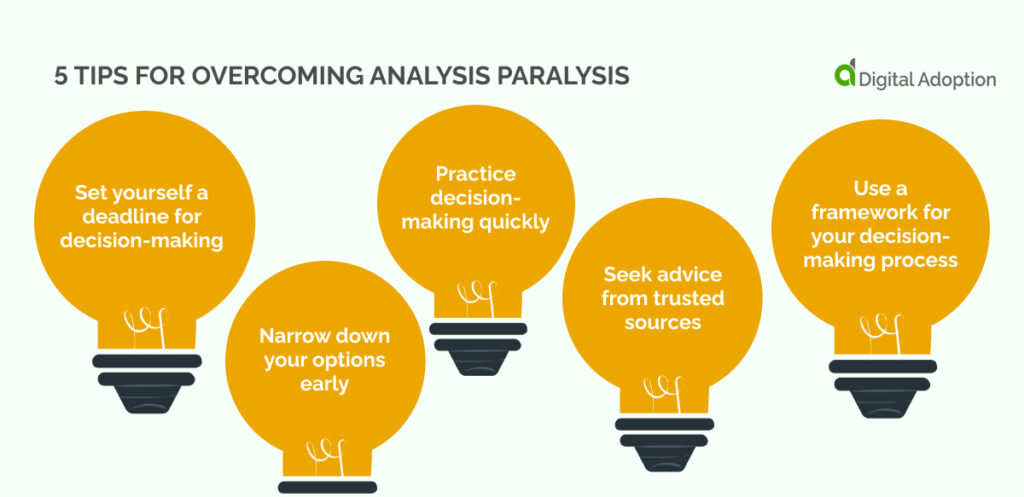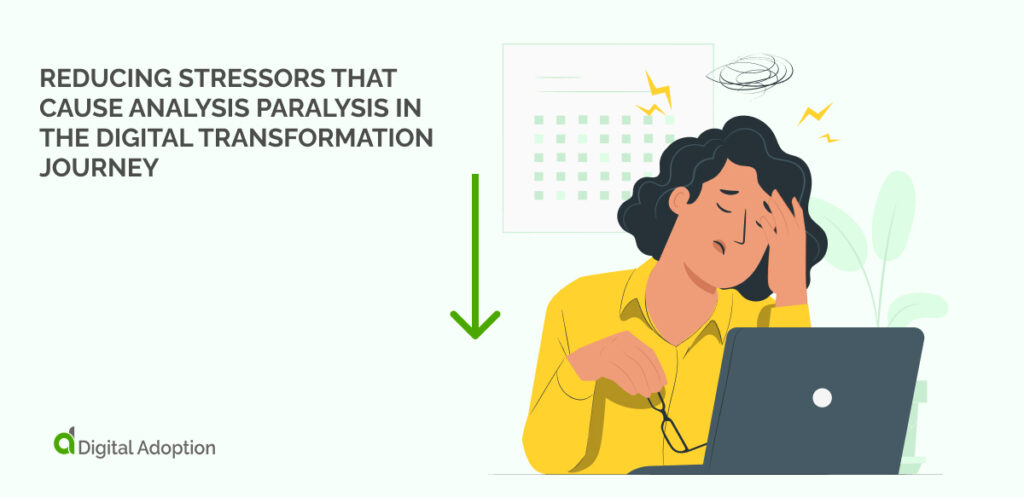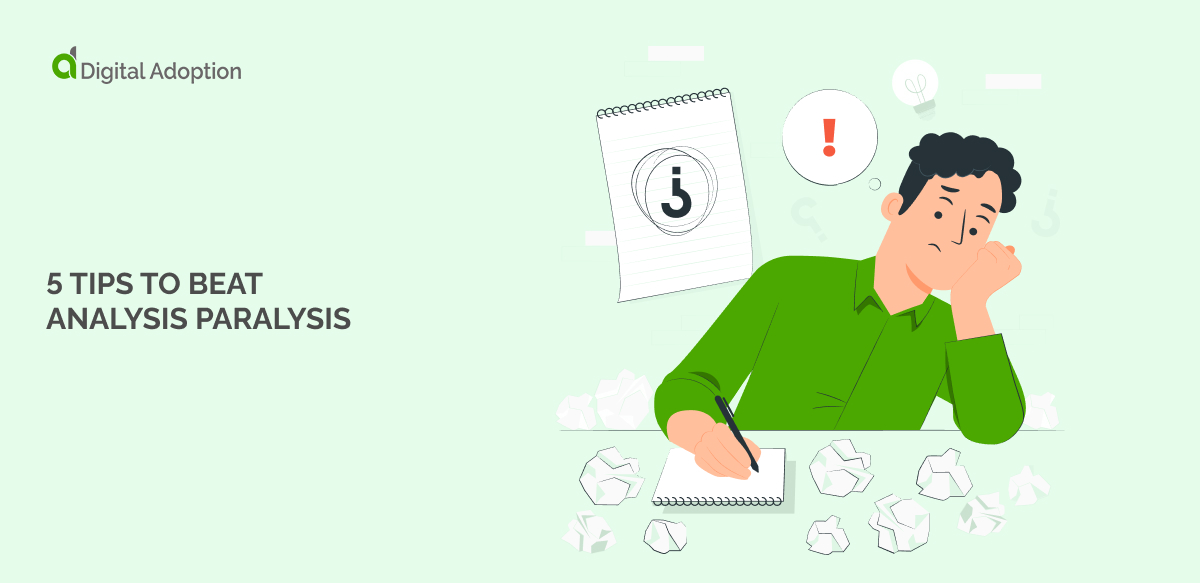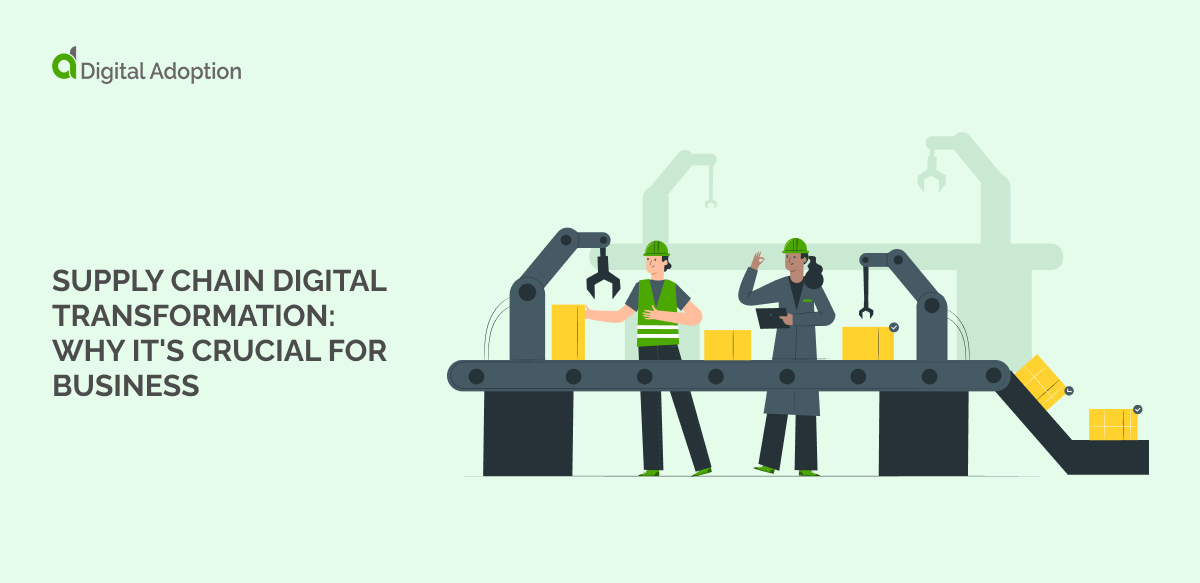Analysis paralysis is like a person stuck in a maze. They can see the possibilities for which direction to turn and have all the information or certainty of knowing the best choice but get caught in an endless search for more information – failing to actually take action, make progress, and gain results.
This can be especially true for organizations on their digital transformation journey as they look to upgrade or implement new systems or technology but may be reluctant to undergo digital adoption. With so much data available to evaluate, it becomes overwhelming. It can cause organizations and employees to find themselves stuck in an endless cycle of researching solutions but never taking action because of the fear of making the wrong choice.
In this article, we explore why businesses need to understand analysis paralysis, the effects of this phenomenon, and how to use technology to help combat it. We will also share five tips on beating analysis paralysis to help organizations start regaining control.
- What Is Analysis Paralysis?
- Why Is It Important For Businesses To Understand Analysis Paralysis?
- How Does Analysis Paralysis Kill Productivity?
- 5 Tips For Overcoming Analysis Paralysis
- The Impacts of Analysis Paralysis on Digital Transformation
- Reducing Stressors that Cause Analysis Paralysis in the Digital Transformation Journey
- Using Technology To Help Prevent Analysis Paralysis
What Is Analysis Paralysis?
Analysis Paralysis is the effect of having too much information at hand when making a decision, leading to an inability to act. This can be due to a need for working memory capacity or excessive research parameters. The basic idea is that an overload of data can make it difficult or even impossible to decide, similar to being paralyzed. This issue is prominent in many industries, from software development to the Harvard Business Review’s coverage of what it calls “choice paralysis.” There is no perfect solution to avoiding wrong decisions, but understanding this phenomenon and following certain guidelines may lead to more positive outcomes.
Why Is It Important For Businesses To Understand Analysis Paralysis?
Understanding analysis paralysis is essential for businesses as it can help them avoid costly mistakes and allow them to make informed decisions. The key is to find the balance between necessary analysis and timely action.
Businesses must have the ability to recognize when research has been exhausted, and a decision needs to be made. They also need to understand how their research habits might impede progress, so they can take appropriate steps to counteract it. With this understanding, businesses can set realistic expectations for their teams, allowing them to make sound decisions quickly while maintaining due diligence.
Organizations must take decisive action to take key opportunities that could positively affect their bottom line. Furthermore, when critical decision-making is put off for too long, it increases the potential for failures and costly mistakes. Such disasters can devastate a company’s reputation and profits in an increasingly competitive market.
Analysis paralysis also inhibits innovation and progress. When teams become bogged down in research and analysis, they need more energy and motivation to pursue groundbreaking ideas or to experiment with new methods. This reluctance to try something new could hinder a company’s ability to stay ahead of the competition or reach lofty goals set by the business’s leadership.
By understanding when analysis has gone too far and recognizing how it affects decision-making processes, businesses can develop systems that help them maintain due diligence when analysis paralysis occurs.
How Does Analysis Paralysis Kill Productivity?
Analysis paralysis kills productivity because it leads to procrastination, distractions, and other inefficient behaviors, which sap our energy and prevent us from accomplishing our tasks. Here are some of the ways analysis paralysis kills productivity:
Decision Overload: Too much information can cause decision overload, which can cause analysis paralysis. When this happens, people often become mired in details and lose sight of the bigger picture. This can lead to an inability to make decisions quickly or efficiently, causing setbacks and delays in progress.
Fear of Making the Wrong Choice: Analysis paralysis can also be caused by fear of making the wrong choice. People may hesitate for too long, fearing their choices won’t turn out well in the end. This fear can be especially pronounced if a significant amount is at stake or risk is involved with any decision.
Unnecessary Perfectionism: Another factor contributing to analysis paralysis is excessive perfectionism – when people become hyper-focused on finding the best solution no matter what it takes (even if they don’t need it). This thinking often wastes time, effort, and resources as we search aimlessly for “perfection” instead of focusing on what needs to be done now.
Analysis paralysis not only kills productivity but can also have serious implications for our mental energy and team dynamics due to decreased morale and lack of motivation around decision-making processes within teams or organizations. To break free from its grip, we must learn how to recognize its signs and cope effectively with potential triggers so that we may move through our day with focus and clarity – allowing us more time for creative work.
5 Tips For Overcoming Analysis Paralysis

Analysis paralysis can be an intimidating challenge. When you’re swamped with data – or too many choices – it can seem like there’s no way forward. However, there are many ways to make decisions quickly and smartly without sacrificing quality. Here are five great tips for beating analysis paralysis organizations can leverage to get around roadblocks and develop the best solution for the situation.
Set yourself a deadline for decision-making.
One way to overcome analysis paralysis is to set a strict decision timeline. This approach forces you to focus on the most important topics and follow through with decisions efficiently rather than wasting time deliberating over every fine detail. This also ensures that any new insights or potential changes to the outcome are captured and included in the final decision.
Narrow down your options early.
Another way to prevent falling into analysis paralysis is to begin narrowing down your choices as early as possible. This can be done by establishing loose criteria for which options are viable solutions, allowing you to eliminate those that do not fit quickly. Consider using a mix of quantitative and qualitative measures so that your choice reflects both efficiency and personal preference.
Practice decision-making quickly
Making decisions quickly doesn’t mean sacrificing quality -if done correctly, it can help reduce analysis paralysis. By practicing rapid-fire decision-making, you can establish a process that allows you to rapidly assess data and make a decisive move without becoming overwhelmed or bogged down in minutiae.
Use a framework for your decision-making process.
Frameworks provide structure when attempting complex tasks such as overcoming analysis paralysis. When applying one of these frameworks, be sure to factor in all relevant information, such as customer feedback, market trends, cost considerations, and more, before coming up with the final solution. Additionally, it’s important to embrace iteration here – don’t be afraid to go back and re-evaluate variables until you find something that works best for the situation at hand.
Seek advice from trusted sources.
Sometimes the best way to break free from analysis paralysis is simply by hearing from someone else who has been there before. Drawing on expert opinions and perspectives may open up doors of possibility that weren’t explored during deliberations – this is especially true when dealing with complex scenarios that require multiple levels of consideration before arriving at an effective solution.
The Impacts of Analysis Paralysis on Digital Transformation
Analysis paralysis can be an obstacle to the successful implementation of digital transformation. It occurs when the decision-making process gets bogged down by overthinking and too much analysis, resulting in no action being taken. This can happen in any organization but is particularly concerning for businesses undergoing a digital transformation and needing agility and iteration to move forward with their initiatives.
The impacts of analysis paralysis on digital transformation include delays in project completion, increased costs due to revisions or rework, and decreased efficiency due to stalled projects. Additionally, analysis paralysis can lead to employee frustration as they become overwhelmed with the complexity of the decisions they must make and the associated stress.
Organizations must have a well-defined decision-making process to overcome these issues, including clear goals and objectives communicated throughout the team. Individuals should also be bold and take risks or experiment as part of their innovation process – failure is sometimes an essential part of success. Furthermore, having regular check-ins and reviews will help keep people focused on their deliverables and minimize any bottlenecks caused by analysis paralysis.
Reducing Stressors that Cause Analysis Paralysis in the Digital Transformation Journey

The digital transformation journey can be daunting, overwhelming experience if you don’t have all your ducks in a row. It’s easy to become stuck and fall into analysis paralysis when deciding your business’s future.
To avoid getting bogged down in this process, it is important to identify and reduce stressors that can lead to analysis paralysis.
To reduce stressors that cause analysis paralysis during the digital transformation journey, it is important to take a step back and reassess objectives and goals. This can help narrow the scope and focus on what must be done now. Additionally, creating a plan of action with checkpoints along the way and a realistic timeline for tasks ensures that there won’t be any rushed decisions that could lead to mistakes or wasted effort.
Ensuring everyone understands their roles and responsibilities so there is clarity about who is responsible for what tasks or decisions will also lead to more efficient decision-making processes. Lastly, leveraging resources like online forums and social media groups where peers in similar digital transformation journeys can offer advice or support might help get you out of analysis paralysis.
Using Technology To Help Prevent Analysis Paralysis
While analysis paralysis is often seen as a hindrance, it can be advantageous when used properly. Fortunately, technology provides plenty of tools to help prevent analysis paralysis and make making decisions quickly and accurately easier.
One way technology can help prevent analysis paralysis is by using analytics software. Analytics software can provide insights into complex problems by analyzing large datasets and making predictions based on those data. This technology can help individuals identify patterns in their data, allowing them to make more informed decisions faster.
Another way technology can help prevent analysis paralysis is by using artificial intelligence (AI) algorithms. AI algorithms are designed to replicate human thinking processes and can be used to automate decision-making processes. By leveraging AI algorithms, organizations can significantly decrease the time spent analyzing data and increase accuracy in decision-making procedures.
Finally, technology also helps prevent analysis paralysis by streamlining communication between stakeholders. Technologies like collaboration software allow teams to share documents in real time, leading to improved collaboration and decision-making processes. Project management tools also enable teams to set task timelines and monitor progress easily, reducing the need for extensive data collection and analysis before taking action.
In conclusion, using technology for analytics, artificial intelligence algorithms, and efficient communication is a powerful tool for preventing analysis paralysis. By leveraging these technologies, organizations can quickly make better decisions while avoiding unnecessary delays caused by too much data or too many options available.













